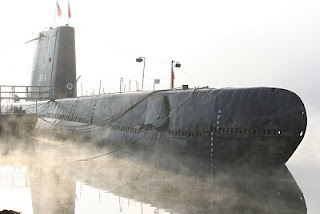
USS
S-26 (SS-131) was designed during the First World War, and were based on the experience gained fighting the German U-Boats of that period.
S-26 was built by the Bethlehem Shipbuilding Corporation at their shipyard in Quincy, MA. Commissioned in 1923, she, along with her sisters of the same "S" class, were the workhorses of the American submarine force in the 1920s and 1930s.
After the Pearl Harbor attack, the Navy decided to press as many submarines into service as possible. Even the "S" class boats, by then near 20 years old and lacking the speed and range of more modern submarines, could be used to patrol areas like the Aleutian Islands, the Philippines, the East Indies and the approaches to the Panama Canal, where their limited performance could be offset by greater numbers, at least until newer submarines could be built.
S-26 was assigned to patrol the Atlantic Ocean approaches to the Panama Canal. On January 24th, the submarine chaser USS
Sturdy (PC-460) was assigned to escort four submarines out to their patrol areas. At 2210,
Sturdy sent the message that, having reached the patrol zone, she was leaving the formation, and that the submarines should begin their assignments.
S-26 did not receive the message.
Since wartime rules were in effect, both
S-26 and
Sturdy were traveling under blackout conditions. Neither the small submarine nor the small patrol boat saw each other in the darkness, and at 2223, USS
Sturdy struck
S-26.
The submarine sank almost immediately. The only survivors were the men on the bridge at the time of the collision - the Commanding Officer, the Executive Officer, and an enlisted lookout.
Although salvage operations were begun immediately, they were unsuccessful. 46 men were lost.
S-26 was never raised.








 The current issue of The Submarine Review has arrived and is in the library.
The current issue of The Submarine Review has arrived and is in the library.